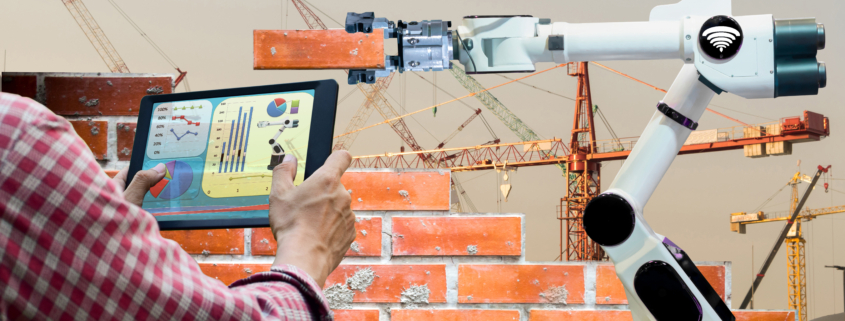How robots are taking BIM to the next level
Robotics and automation are already helping to reduce risk to humans and increase productivity on building sites, writes Pete Felton, Business Development Executive at the National Robotarium.
FROM its early use on films such as Rocky, Marathon Man, and The Shining through to its modern appearances at the side of football matches and other sporting clashes, the Steadicam has revolutionised the life of camera operators, removing much of the strain of manoeuvring heavy equipment from their shoulders and arms. Soon, construction workers should be benefiting from similar assisted technology too.
In the same way that the Steadicam rig helps camera operators by spreading the weight of cameras, batteries, and monitors throughout their core, engineers are developing systems to aid construction workers in handling heavy tools. Rather than putting the pressure on workers’ shoulders or arms, these robotic structures should help to spread the load, cutting down on the number of potential workplace injuries.
Other robotic systems are already making a difference on construction sites. Hilti’s Jaibot semi-autonomous drilling robot is harnessing data from building information modelling (BIM) systems to carry out mechanical, electrical, and plumbing (MEP) installation tasks such as overhead drilling, both improving productivity and reducing the strain on human workers.
Helping to narrow the skills gap
That focus on health and safety is one of the key areas in which robotics and automation can help to take people away from dangerous and dirty jobs, helping to improve the quality of life for everyone. Robots and people can work side by side in safety.
This isn’t about robots taking people’s jobs – there’s a massive skills shortage in the construction industry and so if we can take workers away from mundane and repetitive jobs and use robots instead then those workers can be retrained to carry out more skilled tasks, adding greater value to projects and giving them more job satisfaction.
Brick-laying machines don’t work well because people are better suited to that type of skilled work. But, in the pre-construction phase, robots could be assembling panels and other prefabricated materials, freeing up people to do tasks on site that require finer skills – such as sealing, plumbing, or installing electrics – which are much harder for robots.

Pete Felton, Business Development Executive at the National Robotarium
Harnessing the power of digital twins
Here at The National Robotarium, we know that it’s no good talking the talk if we don’t walk the walk as well. That’s why we used a Spot robot – built by Boston Dynamics and kitted out with sensors by our team – to inspect our building site at night when construction was underway on our flagship facility.
This type of simultaneous localisation and mapping work is going to become even more important when stricter building regulations are introduced throughout the UK. Robots can help to gather the data that will be needed to prove that construction projects comply with environmental regulations – if robots don’t carry out this type of work then construction companies will need to employ people, at significant expense, to carry out mundane tasks such as checking sealant and auditing insulation.
Ultimately, using robots to gather data will enable the creation of digital twins while office blocks and industrial projects are being constructed, creating an accurate record of where each wire, cable, pipe, and duct is situated. Those digital twins can then be passed on by the builder to the facilities manager, making the maintenance of properties much easier and creating a digital link all the way through from the architect to the maintenance staff.
Widening opportunities for export success
As well as improving conditions for workers and increasing productivity in the UK, the greater use of robotics and automation could also generate an economic boost for Britain through exports too. If British construction companies harness the power of robots then the technologies they create and the expertise they develop could be exported to markets throughout the world.
The building boom across the Gulf States and the wider Middle East is set to be eclipsed by the growth of the affluent middle classes in India, with the ensuing need for buildings that rapid urbanisation will bring. Such growth can only be achieved in an environmentally sustainable way if robotics and automation are harnessed throughout the construction process, from prefabrication through to retrofitting of existing buildings to make sure they keep dwellers cool in the summer and warm in the winter.
BIM and automation go hand-in-hand when it comes to energy efficiency, both for cooling systems and heating systems, making sure that buildings consume as little power as possible. If we get these factors correct in the UK then we can export that expertise around the world.
Health and safety and digital twinning are just two of the exciting areas in which robots can make a difference to building projects, but our engineers are always looking to work with staff at the sharp end of the construction industry to come up with new ideas – that’s why the doors at The National Robotarium are always open for collaborations.
This article was originally published in BIM Plus magazine on 11 January 2024.







